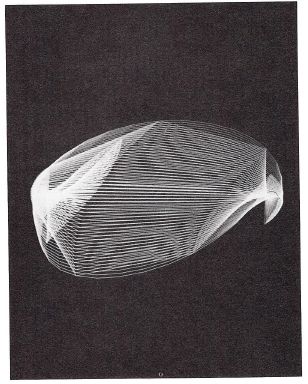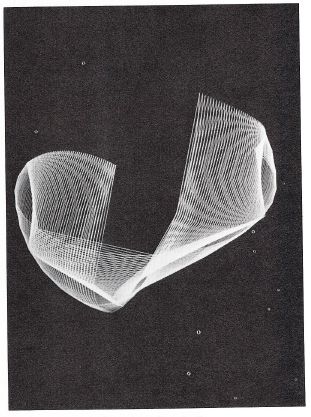HERBERT W. FRANKE
GRAPHIC MUSIC
The question, what was there before: the idea or the medium, is lively discussed among scientists. The technical medium, is it created only as soon as the idea is there? For its realization is it needed? Or is it the technical know-how from which arises the stimulation of an idea? Practice shows us examples for both cases, where the fundamental rule is of value: the availability of technical knowledge and technical means presents a limiting factor for the realization of ideas. This rule is of value not only for art but also for technology.

We may conceive of artworks as offers to perception. Every presentation of art must give an opportunity for a conveyance of information. The particularity of aesthetic communication lies in a purposeful preparation of the information-model, an adaption to the ability and readiness for the perceptible reception, and the working up toward the addressee. Therefore it is particularly important that the process of perception succeeds well and continues for a long time.
An inventory of the realm of art, shows us that it is possible to have a distribution of the types of art beyond the sense-channel. Next we have to decide whether the art form is a static or kinetic, temporarily changeable, presentation.
| Heavy-Weight of the Presentaion | Static | Kinetic | |
| EYE | Syntactic | Irrelevant Picture | ? (Starts in fireworks, water plays, kaleidoscope, etc.) |
| Semantic | Graphic Picture | Silent film, pantomime written text | |
| EAR | Syntactic | Music | |
| Semantic | Static Auditive Presentation | Recitation, radio-play | |
| EYE AND EAR | Syntactic | Not Practicable | Starts in irrelevant animated cartoons and experimental-film, partly ballet |
| Semantic | Sound-film, theater, and the like, partly ballet |
In this table only the senses seeing and hearing, which are essential for art, are considered. However, there are artlike activities which appeal to other sense-organs, for example the 'art of cooking.' But the spectrum of impressions derivable from cooking is too narrow to produce the abundance and variety of impressions that we expect from a genuine art.
A further point which is very important for art is the distinct effect on the syntactic and semantic planes respectively. It is the distinction between irrelevant models, which impress perhaps with formal or harmonical beauty, and the enciphering of sense capacity. Man is able to set his mind separately upon different planes of structuring, for example on the syntactical and on the semantical one, but understandably the inclination is to occupy himself first with 'sense' statements and the like. Only in subsequent manufacturing phases result the abstracting mental attitude to other order systems anchored in art objects.
In the table a certain spot is marked by a question mark. The point represents the unobjective visual presentation which corresponds to music in the realm of auditive art forms.
This is a good example of how much the lack of technical means may influence cultural developments. While in music there were very early technical mediums for managing sound-effects, the real possibilities lie in the visual realm, but were not realized. The idea of a graphic play of forms, 'Graphic Music' could only be realized since the development of optical-electronic means.
Therefore we ask whether the requirement of such an art form exists. Often it is presumed that the absence of such an artform goes back to the deficiency of this need. But it shows that man possesses an appreciation of forms and colors in dynamic movement. The fascination starting from the observation of waterwaves and flames is a proof of this. But there are also historical examples where there were attempts to create techniques to realize this idea. Examples of this are fireworks, artificial water-plays, perhaps fountains illuminated in colors and the Kaleidoscope. But all these techniques have many faults. For instance it is difficult to control these apparitions. Moreover, they offer a relatively small complexity of perceptual effects. A principle possibility for the realization of 'Graphic Music' was offered first by the trickfilm in its original form, the animated cartoon; practicability is missing. The production of phase pictures is extremely troublesome, taking up much time and is very expensive. This example clearly shows that technical means alone are inadequate; economic feasibility is also required. Another assumption relates to control. The physical and psychological qualities must be performed with a relatively high exactitude where the degree of accuracy is determined by the power of distinction of the sense-organs. It is required that, by means of an Artform, there should be produced the best possible realization if it shall not exhaust itself too quickly. But this is only possible if one bestows a certain complexity to the aesthetical pattern. If you use a graphform, which is very inaccurate and superimposed by chance, this complexity is highly restricted. The possibilities determined by the certain artform will be reduced unnecessarily; the band-width of the human senses is not utilized. The most favorable conditions are where one can produce elements for constructing aesthetical patterns with high exactitude so that they may be described and reproduced. Then it is possible to build up these elements to greatly varied aggregations.
The best example of this is western harmonic music with its different styles. Music-instruments are nothing else than physical precision-machines which allow us to produce exactly reproducible acoustic effects. Experience shows that small deviations from the elementary frequencies, instruments out of tune, make it very difficult to obtain recordings of high quality, and produce unpleasant experiences with perception.
The first technical instrument which allows us to realize the idea of graphic music is the computer with an annexed graphic delivery gear. Elementary units, for example may be line-elements or tokens arranged in a screen. The first computer-graphic installations offered only very restricted possibilities. They used the same methods as in film making with the only difference being that the production of the phase-pictures was controlled according to a program. The transition allows one to view graphic motion-pictures in real time on the fluorescent screen. Interactive systems allow direct exertion of influence on the produced pictures. Thus it becomes possible to go beyond the projected linear course—as it relates to film and to become a sort of 'Graphic improvisation.' Corresponding to what is usual in music, the field of computer-art was founded, breaking new ground and filling a particular void in the scheme of possible Art-forms.
In this direction there were executed practical experiments, especially by John Whitney and his sons and by Kenneth Knowlton and Lillian Schwartz. In the Siemens Research Laboratory the author had access to an installation which was capable of free graphic improvisation through its interactive system. A program written by Gerhard Geitz, Monika Gonauser, Egon Horbst and Peter Schinner for the projection of rotating geometric figurations was enlarged so that a Groundstructure of harmonical geometric courses grew possible. Through aesthetical exploitation the picture elements are built up successively in regular space-angle intervals leading to wandering superpositions, whose projections execute complicated movements upon the picture plane. This fundamental course serves so to speak, as raw material for further processing, which now takes place interactively. Angle intervals and rate of change of position may be modified. A choice of large angle-intervals introduces the effect of chance and the diminution of the angle-interval of the heterogyne figures leads back again to a state of original order.
This program offers quiet and harmonical picture influences where the degree of order is still raised by symmetric and counter-running movements. Although from the console only a few parameters may be changed, it is still possible to obtain a wide variety of effects. The interspersing of stochastical effects (where the harmony is destroyed) form very drastic phases in the regularity of movement.

Out of our perception-customs we are trained to recognize visual and auditive Information-patterns. The lack of sound in the described courses is felt very negatively on several sides. Conceivably it would be possible to enlarge the program to include auditive effects. However, another possibility was used—musicians freely improvised with simultaneously projected graphical passages. From this two ten-minute Computer films 'Rotations' and 'Projections' were produced. The sound for one film was added during a Computer-Workshop in July 1974, in Bonn where musicians freely improvised with electronic instruments. The sound for the second film was added at the International Musicforum 1974 in Breitenbrunn, Burgenland, Austria. This time some highly qualified free-jazz musicians participated. Participating in this experiment was a group of ten musicians. During another showing of the film a smaller group took part, among them Karl Berger and Fritz Bauer.

The presentation took place in public, incorporating the audience into the experiment. In the discussion which followed every participant could express his interpretation. Overall the reaction was positive. However, the visual display was difficult for people to relate to. It was too unusual to make value judgments. While our environment confronts us from childhood with musical presentations, we bring along scarcely any knowledge of graphic passages. Evidently, because of this, the natural understanding we have in music is missing, which causes rapid fatigue. The spectator asks for more variety in graphical presentations than he does in acoustical presentation. Such performances of abstract graphic plays should not surpass ten minutes with an uninitiated public. Apart from objections of this sort, the effects on the public were extremely favorable. It shows that graphical music offers the potential to develop into a complex and differentiated form, as is the case with usual music. With film and television we have today at our disposal the optical means of delivery and the practical assumptions for the spreading of new aesthetical forms of presentation. These could grow to a genuine enrichment of our cultural life.
Munich, W. Germany
August 1975
Return to Table of Contents | Previous Section | Next Section

